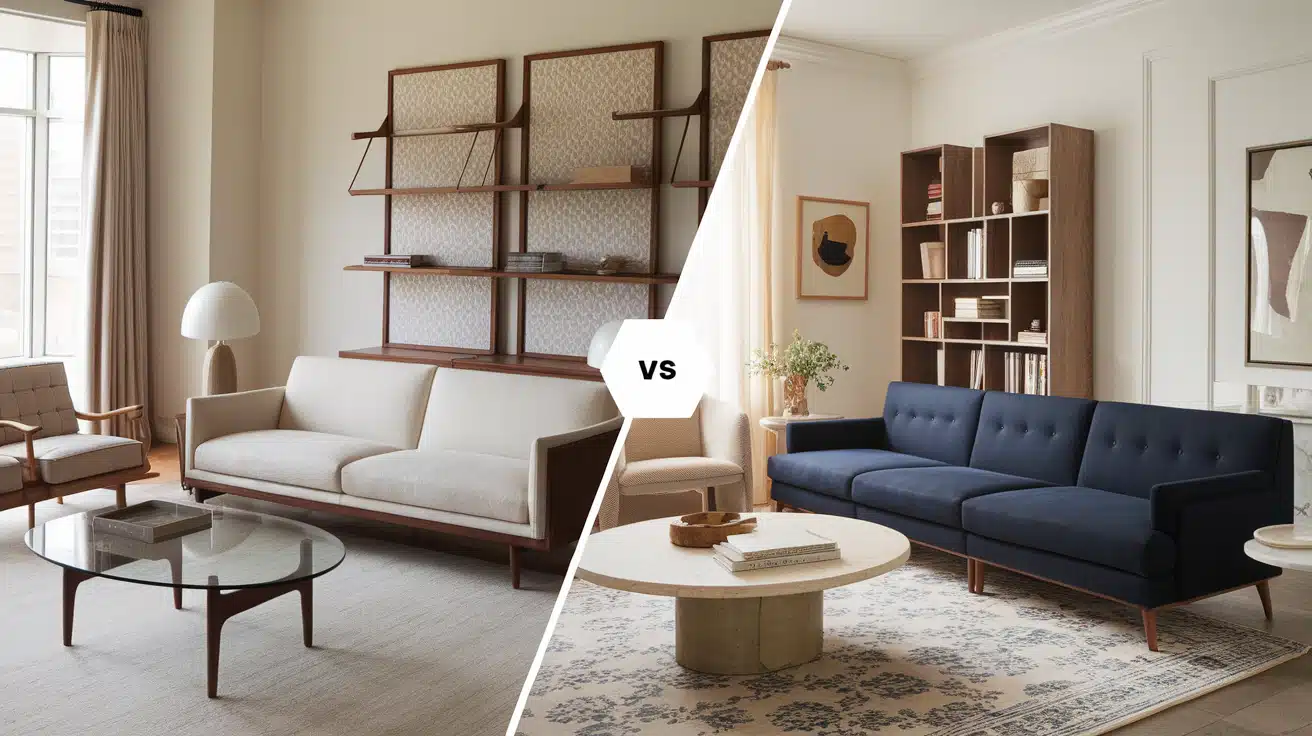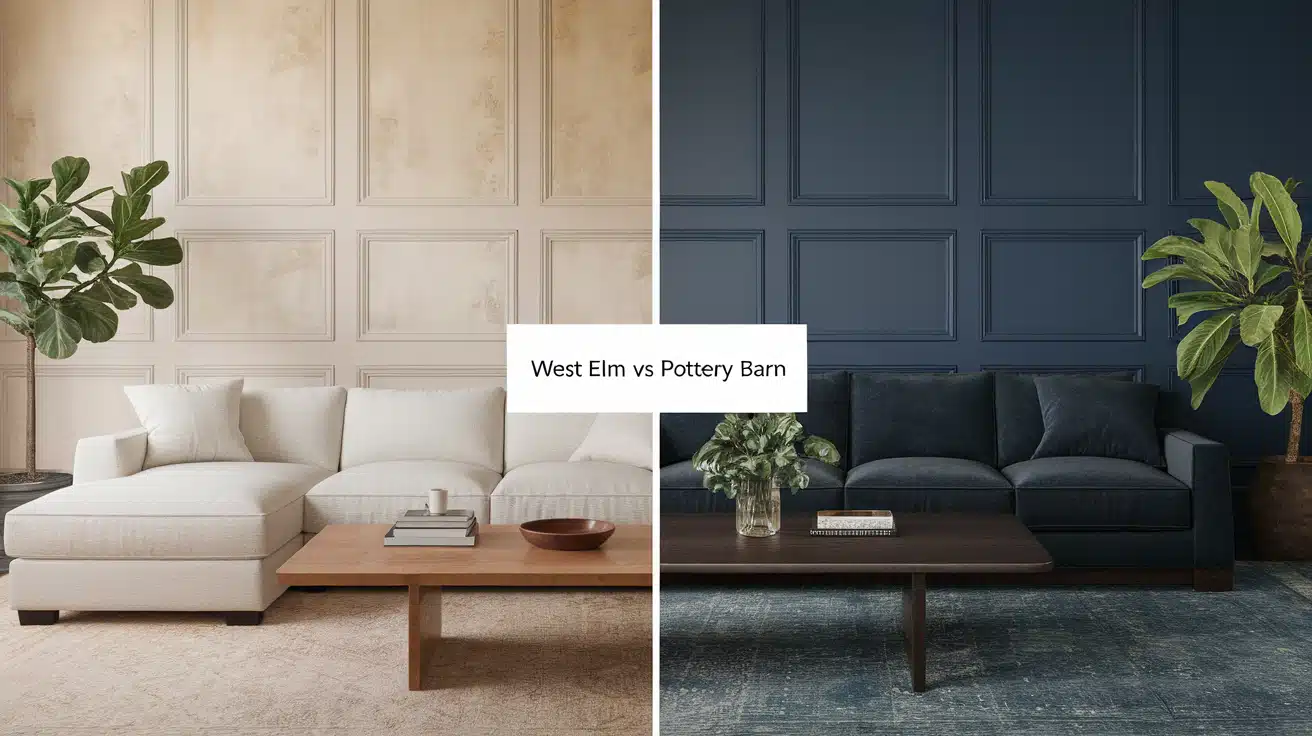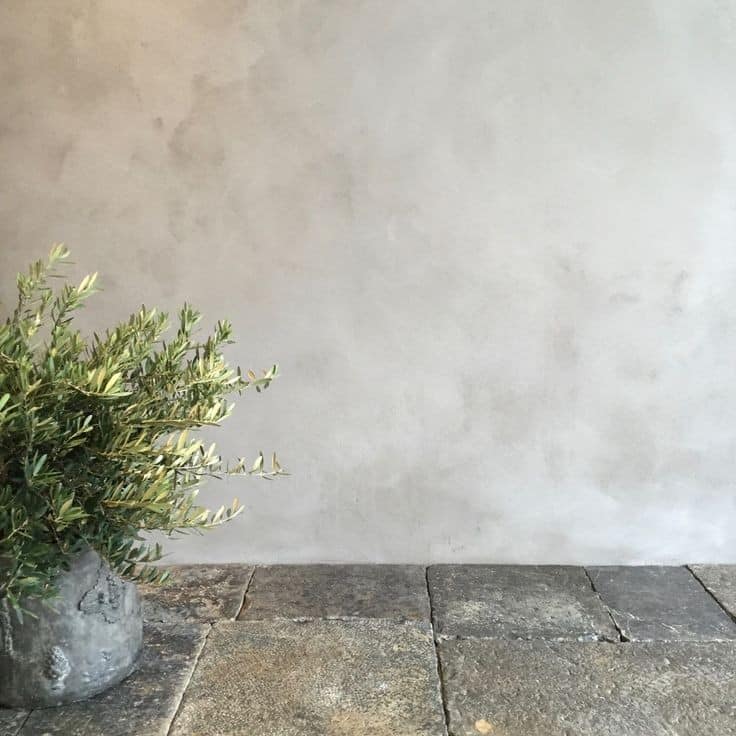West Elm vs Pottery Barn: A Comprehensive Comparison
Setting up a home requires careful thought about where to buy furniture. Two names often come up in this search: West Elm and Pottery Barn. These stores, both part of the Williams-Sonoma family, offer distinct approaches to home furnishing.
People looking for furniture often wonder which store better suits their needs. This question becomes more important when planning to invest in pieces that should last for years.
Each store brings its own character to home design, from the materials it chooses to the styles it creates.
Our side-by-side comparison of these stores will help you understand their style, quality, and price differences. We’ll explore what makes each store special and how it might fit your home needs and budget.
Company Overviews
These two well-known furniture brands bring something special to home design, though they started in different times and places. Let me walk you through their stories.
West Elm
Born in Brooklyn in 2002, West Elm quickly found its place in the hearts of city dwellers. The brand focused on bringing fresh designs to homes at fair prices. Their furniture works well in smaller spaces, making it perfect for apartment living.
What sets West Elm apart is its commitment to doing good. It works with small local businesses and supports craftspeople worldwide. Its products often feature materials that help protect the environment.
By 2024, more than half of its wooden furniture will come from responsible forest sources.
Pottery Barn
Pottery Barn’s story began in 1949 New York City when Paul Secon started selling unique dishes and home items. Over the years, it grew from a small shop into a beloved name in home furnishings.
The brand stands for lasting quality and classic style. Its furniture is beautifully suited to many types of homes, from small cottages to large houses. Its pieces often show careful attention to detail and skilled craftsmanship.
Both brands now belong to Williams-Sonoma Inc., but each keeps its special character. They serve different needs and tastes, helping people create homes they love in their ways.
Design and Style Comparison
Each brand has its own distinct look. Here’s a clear breakdown of how West Elm and Pottery Barn differ in their design choices.
| Design Element | West Elm | Pottery Barn |
|---|---|---|
| Main Style | Mid-century modern and city-inspired looks | Traditional and country-inspired designs |
| Color Choices | Muted tones with bright accents | Warm earth tones and soft neutrals |
| Materials | Glass, metal, solid wood | Solid wood, cotton, linen |
| Furniture Lines | Slim, straight, compact | Full, rounded, spacious |
| Room Size Fit | Works in small spaces and apartments | Best for larger rooms and homes |
| Pattern Types | Simple shapes, modern prints | Classic stripes, plaids, florals |
| Sofa Styles | Low-profile, compact seating | English roll arms, slip-covered designs |
| Lighting | Simple metals, glass fixtures | Classic lanterns, warm-toned metals |
| Wood Finishes | Light to medium tones | Medium to dark tones |
| Target Setting | Urban homes, modern spaces | Country homes, classic spaces |
Let’s look at how these styles work in real homes. West Elm pieces shine in city apartments and modern houses. Their furniture fits well with simple art and clean spaces.
Pottery Barn furnishings feel home in family houses and spaces that value comfort. Their items mix well with collected treasures and family photos.
When choosing between them, consider your home’s natural style. West Elm suits those who like simple, fresh looks, while Pottery Barn works for those who want a cozy, timeless feel.
Product Range
Here’s a detailed comparison of what you’ll find at both stores:
| Category | West Elm | Pottery Barn |
|---|---|---|
| Living Room |
|
|
| Dining Room |
|
|
|
Bedroom |
|
|
| Lighting |
|
|
| Textiles |
|
|
| Wall Décor |
|
|
| Special Features |
|
|
Both stores regularly update their selections to match current styles while maintaining their distinct identities. Their products range from furniture to the smallest home accents, letting you create a complete look for your space.
Pricing and Value for Money
Let me break down the costs and value you get from each store to help you make smart buying choices.
| Product Category | West Elm | Pottery Barn | Quality Comparison |
|---|---|---|---|
| Sofas | $899 – $2,999 | $999 – $3,499 | PB offers better upholstery and frame construction |
| Dining Tables | $599 – $1,899 | $799 – $2,499 | Similar quality, PB tends to be larger |
| Bed Frames | $699 – $1,999 | $899 – $2,299 | Comparable quality, style differences |
| Area Rugs (8×10) | $599 – $899 | $799 – $1,500 | PB uses more natural fibers |
| Floor Lamps | $200 – $600 | $200 – $600 | Similar quality and materials |
| Throw Pillows | $29 – $99 | $39 – $129 | PB offers better filling quality |
Sustainability and Ethical Practices
Let me outline how each brand approaches environmental and ethical concerns.
West Elm’s Commitment
West Elm is committed to sustainability. Its cotton bedding and bath towels come from responsible sources, and over half of its wooden furniture uses certified wood from protected forests.
The company invests $13.2 million in small American businesses and $200 million in global artisan groups.
Pottery Barn’s Approach
Pottery Barn aims to make positive changes through its practices. It plans to plant 6 million trees and aims to reach a complete carbon balance by 2025. Many of its products use certified wood and organic cotton. It also focuses on making items that last longer to reduce waste.
Comparison
| Factor | West Elm | Pottery Barn |
|---|---|---|
| Material Certifications |
• GOTS Certified • FSC Certified • OEKO-TEX Standard • Global Recycled Standard |
• GOTS Certified • FSC Certified • OEKO-TEX Standard • Greenguard Gold |
| Labor Programs |
• Fair Trade USA • Better Cotton Initiative • HERproject • Local Maker Support |
• Fair Trade USA • Better Cotton Initiative • HERproject • Renewal Workshop |
| Environmental Goals |
• 52% sustainable wood • 100% cotton sustainability • Water-saving methods •Local production support |
• Carbon neutral by 2025 • 6 million trees by 2023 • Recycled materials use • Waste reduction plans |
| Community Impact |
• $13.2M to US businesses • $200M to artisan groups • Global maker partnerships • Small business focus |
• Better worker conditions • Fair trade partnerships • Community support • Global artisan work |
| Product Longevity |
• Reusable materials • Fixable designs • Quality testing • Repair options |
• Long-lasting builds • Family inheritance quality • Solid construction• Replaceable parts |
Making the Decision

Finding the right store for your home needs comes down to understanding what matters most to you. Let me explain this clearly to help you choose.
Who Should Choose West Elm
West Elm speaks to city dwellers and those embracing modern life. The brand’s furniture works beautifully in apartments and smaller homes where space matters. Their pieces bring a fresh feel with clean shapes and simple designs.
Many young professionals choose West Elm when setting up their first home. The prices work well for those starting, and the furniture adapts easily to different spaces. They excel at creating pieces that work in many room layouts.
The store attracts shoppers who care about where their furniture comes from. Its support of small makers and earth-friendly practices appeals to those who consider their buying impact. The materials it uses, like light woods and metals, match well with today’s home styles.
Who Should Choose Pottery Barn
Pottery Barn draws those who value lasting quality and classic style. Their furniture suits larger homes and spaces where comfort takes center stage. Families often choose this brand for its sturdy construction and timeless designs.
The store serves those looking to create a home that will last through the years. Their pieces often become treasured family items passed down through generations. The natural materials and warm finishes create a welcoming feel in any room.
Shoppers who want coordinated room designs find success with Pottery Barn. Their collections work together seamlessly, making it easy to create a complete look. The investment in their furniture pays off through years of use and enjoyment.
Conclusion
Your home tells your story. Both West Elm and Pottery Barn can help tell that story but in different ways.
West Elm brings a fresh take on home furnishing, perfect for those who value modern simplicity.
Their focus on supporting small makers and caring for our planet adds meaning to each piece. The brand fits well with city life and spaces that welcome change.
Pottery Barn carries forward a tradition of quality and comfort. Their furniture creates spaces where families grow and memories form.
Each piece shows careful work and attention to detail, built to stay beautiful through years of daily use.
Remember, there’s no wrong choice – only the right choice for your home. Both stores offer quality pieces that can make your space feel complete.







